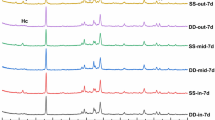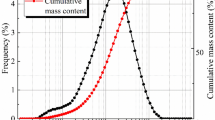Abstract
This paper studies the mechanism of anti-washout performance of hydroxypropyl methylcellulose (HPMC) and polyacrylamide (PAM) in seawater-mixed cement paste. Using seawater as concrete mixing water can reduce the consumption of freshwater resources. The ionic environment of seawater can promote hydrogen bonds formation of HPMC, and PAM. The viscosity of the solution increased with the numbers of hydrogen bonds, thus, the viscosity of seawater-mixed cement paste increased by incorporating HPMC and PAM. The viscosity of admixtures (AWA) solution is a major determinant of the viscosity and washout resistance of cement paste. Incorporating HPMC can significantly reduce underwater seawater-mixed cement paste washout loss from 59.8 to 0%, while incorporating PAM can reduce it from 59.8 to 2.8%. Compared with PAM, HPMC has better anti-washout effect because of its high viscosity in seawater-mixed solution. This research reports an effective method to improve the washout resistance performance of seawater-mixed cement paste through polymer doping and illustrates the feasibility of using seawater instead of freshwater applied in the underwater anti-washout cement paste.












Similar content being viewed by others
References
Cheng H, Hu Y, Zhao J (2009) Meeting China’s water shortage crisis: current practices and challenges. Environ Sci Technol 43(2):240–244. https://doi.org/10.1021/es801934a
Hadadin N et al (2010) Water shortage in Jordan—Sustainable solutions. Desalination 250(1):197–202. https://doi.org/10.1016/j.desal.2009.01.026
Loáiciga HA et al (2020) Evaluation of water shortage crisis in the Middle East and possible remedies. J Water Supply Res Technol Aqua 69(1):85–98. https://doi.org/10.2166/aqua.2019.049
Mekonnen MM, Hoekstra AY (2016) Four billion people facing severe water scarcity. Sci Adv 2(2):e1500323. https://doi.org/10.1126/sciadv.1500323
Miller SA, Horvath A, Monteiro PJM (2016) Readily implementable techniques can cut annual CO2 emissions from the production of concrete by over 20%. Environ Res Lett 11(7):074029. https://doi.org/10.1088/1748-9326/11/7/074029
Miller SA, Horvath A, Monteiro PJM (2018) Impacts of booming concrete production on water resources worldwide. Nat Sustain 1(1):69–76. https://doi.org/10.1038/s41893-017-0009-5
Monteiro PJM, Miller SA, Horvath A (2017) Towards sustainable concrete. Nat Mater 16(7):698–699. https://doi.org/10.1038/nmat4930
Younis A et al (2018) Fresh and hardened properties of seawater-mixed concrete. Constr Build Mater 190:276–286. https://doi.org/10.1016/j.conbuildmat.2018.09.126
Assaad JJ, Issa CA (2012) Bond strength of epoxy-coated bars in underwater concrete. Constr Build Mater 30:667–674. https://doi.org/10.1016/j.conbuildmat.2011.12.047
Guo H et al (2021) Ultra-stable anti-washout cement grout achieved by super water absorbing villus-like nanocomposite hydrogel. Constr Build Mater 301:124035. https://doi.org/10.1016/j.conbuildmat.2021.124035
Ohama Y (1997) Recent progress in concrete-polymer composites. Adv Cem Mater 5(2):31–40. https://doi.org/10.1016/S1065-7355(96)00005-3
Miller S, Shemer H, Semiat R (2015) Energy and environmental issues in desalination. Desalination 366:2–8. https://doi.org/10.1016/j.desal.2014.11.034
Ahmad Zaidi FH et al (2021) Geopolymer as underwater concreting material: a review. Constr Build Mater 291:123276. https://doi.org/10.1016/j.conbuildmat.2021.123276
Ge X et al (2020) Characteristics of underwater cast and cured geopolymers. Cement Concr Compos 114:103783. https://doi.org/10.1016/j.cemconcomp.2020.103783
Grzeszczyk S et al (2019) The role of nanoparticles in decreased washout of underwater concrete. Constr Build Mater 203:670–678. https://doi.org/10.1016/j.conbuildmat.2019.01.118
Ali Sikandar M et al (2020) Effect of various anti-washout admixtures on the properties of non-dispersible underwater concrete. Constr Build Mater 245:118469. https://doi.org/10.1016/j.conbuildmat.2020.118469
Etxeberria M, Gonzalez-Corominas A, Pardo P (2016) Influence of seawater and blast furnace cement employment on recycled aggregate concretes’ properties. Constr Build Mater 115:496–505. https://doi.org/10.1016/j.conbuildmat.2016.04.064
Frias M et al (2013) Seawater effect on durability of ternary cements. Synergy of chloride and sulphate ions. Compos B Eng 46:173–178. https://doi.org/10.1016/j.compositesb.2012.09.089
Li Q et al (2015) Effect of metakaolin addition and seawater mixing on the properties and hydration of concrete. Appl Clay Sci 115:51–60. https://doi.org/10.1016/j.clay.2015.06.043
Mohammed TU, Hamada H, Yamaji T (2004) Performance of seawater-mixed concrete in the tidal environment. Cem Concr Res 34(4):593–601. https://doi.org/10.1016/j.cemconres.2003.09.020
Khayat KH, Sonebi MJMJ (2001) Effect of mixture composition on washout resistance of highly flowable underwater concrete. Mater J 98(4):289–295
Chen CC et al (2010) Properties of anti-washout-type calcium silicate bone cements containing gelatin. J Mater Sci Mater Med 21(4):1057–1068. https://doi.org/10.1007/s10856-009-3948-1
Assaad JJ et al (2019) Assessment of bond strength of underwater polymer-modified concrete. ACI Mater J 116(6):169–178. https://doi.org/10.14359/51716982
Łaźniewska-Piekarczyk B (2013) The type of air-entraining and viscosity modifying admixtures and porosity and frost durability of high performance self-compacting concrete. Constr Build Mater 40:659–671. https://doi.org/10.1016/j.conbuildmat.2012.11.032
Leemann A, Winnefeld F (2007) The effect of viscosity modifying agents on mortar and concrete. Cem Concr Compos 29(5):341–349. https://doi.org/10.1016/j.cemconcomp.2007.01.004
Sonebi M, Lachemi M, Hossain KMA (2013) Optimisation of rheological parameters and mechanical properties of superplasticised cement grouts containing metakaolin and viscosity modifying admixture. Constr Build Mater 38:126–138. https://doi.org/10.1016/j.conbuildmat.2012.07.102
Boshoff W et al (2020) The effect of superabsorbent polymers on the mitigation of plastic shrinkage cracking of conventional concrete, results of an inter-laboratory test by RILEM TC 260-RSC. Mater Struct 53(4):1–16. https://doi.org/10.1617/s11527-020-01516-6
Schröfl C, Mechtcherine V, Gorges M (2012) Relation between the molecular structure and the efficiency of superabsorbent polymers (SAP) as concrete admixture to mitigate autogenous shrinkage. Cem Concr Res 42(6):865–873. https://doi.org/10.1016/j.cemconres.2012.03.011
Liu Q et al (2021) A mechanical strong polymer-cement composite fabricated by in situ polymerization within the cement matrix. J Build Eng 42:103048. https://doi.org/10.1016/j.jobe.2021.103048
Shi S-C, Wu J-Y, Huang T-F (2016) Raman, FTIR, and XRD study of MoS2 enhanced hydroxypropyl methylcellulose green lubricant. Opt Quantum Electron 48(10):1–9. https://doi.org/10.1007/s11082-016-0748-y
Ding C, Zhang M, Li G (2015) Preparation and characterization of collagen/hydroxypropyl methylcellulose (HPMC) blend film. Carbohydr Polym 119:194–201. https://doi.org/10.1016/j.carbpol.2014.11.057
Wang S et al (2014) Properties of polyvinyl alcohol/xylan composite films with citric acid. Carbohydr Polym 103:94–99. https://doi.org/10.1016/j.carbpol.2013.12.030
Sivanantham M et al (2008) Stimulus response and molecular structural modification of polyacrylamide gel in nitric acid a study by Raman, FTIR, and photoluminescence techniques. J Polym Sci Part B Polym Phys 46(7):710–720. https://doi.org/10.1002/polb.21402
Jia Y et al (2019) Construction of highly stretchable silica/polyacrylamide nanocomposite hydrogels through hydrogen bond strategy. J Polym Res 26(5):1–9. https://doi.org/10.1007/s10965-019-1761-1
McCafferty E et al (1998) Determination of the concentration of surface hydroxyl groups on metal oxide films by a quantitative XPS method. Surf Interface Anal Intern J Devot Dev Appl Tech Anal Surf Interfaces Thin Film 26(8):549–564
van den Brand J et al (2004) Correlation between hydroxyl fraction and O/Al atomic ratio as determined from XPS spectra of aluminium oxide layers. Surf Interface Anal 36(1):81–88. https://doi.org/10.1002/sia.1653
Sato Y, Niwa O, Mizutani F (2007) Hydrogen bonding interaction between aminopurinethiol-monolayers and oligonucleotides by QCM and XPS measurements. Sens Actuators B Chem 121(1):214–218. https://doi.org/10.1016/j.snb.2006.09.011
Stevens JS et al (2014) Proton transfer and hydrogen bonding in the organic solid state: a combined XRD/XPS/ssNMR study of 17 organic acid-base complexes. Phys Chem Chem Phys 16(3):1150–1160. https://doi.org/10.1039/c3cp53907e
Jiang K et al (2019) Insight into the relationship between viscosity and hydrogen bond of a series of imidazolium ionic liquids: a molecular dynamics and density functional theory study. Ind Eng Chem Res 58(40):18848–18854. https://doi.org/10.1021/acs.iecr.9b02535
Ma Y et al (2018) Relationship between hydrogen bond and viscosity for a series of pyridinium ionic liquids: molecular dynamics and quantum chemistry. J Mol Liq 255:176–184. https://doi.org/10.1016/j.molliq.2018.01.121
Benaicha M et al (2015) Influence of silica fume and viscosity modifying agent on the mechanical and rheological behavior of self compacting concrete. Constr Build Mater 84:103–110. https://doi.org/10.1016/j.conbuildmat.2015.03.061
AzariJafari H et al (2016) Effects of pre-soaked super absorbent polymers on fresh and hardened properties of self-consolidating lightweight concrete. Constr Build Mater 113:215–220. https://doi.org/10.1016/j.conbuildmat.2016.03.010
Bani Ardalan R, Joshaghani A, Hooton RD (2017) Workability retention and compressive strength of self-compacting concrete incorporating pumice powder and silica fume. Constr Build Mater 134:116–122. https://doi.org/10.1016/j.conbuildmat.2016.12.090
Lu C, Yang H, Mei G (2015) Relationship between slump flow and rheological properties of self compacting concrete with silica fume and its permeability. Constr Build Mater 75:157–162. https://doi.org/10.1016/j.conbuildmat.2014.08.038
Sun Z, Xu Q (2008) Micromechanical analysis of polyacrylamide-modified concrete for improving strengths. Mater Sci Eng A 490(1–2):181–192. https://doi.org/10.1016/j.msea.2008.01.026
Xu Q et al (2009) Laboratory testing material property and FE modeling structural response of PAM-modified concrete overlay on bridges. J Bridge Eng 14(1):26–35
Acknowledgements
This work was funded by National Natural Science Foundation of China, Excellent Young Scientists Fund (HK&Macau) (File No. 5212290021); Shenzhen-Hong Kong-Macao science and technology plan (c) (File No. SGDX2020110309360); The Science and Technology Development Fund, Macau SAR (File No. 0138/2020/A3) and Research & Development Grant for Chair Professor (File no. CPG2022-00010-IAPME) from University of Macau.
Author information
Authors and Affiliations
Corresponding authors
Ethics declarations
Conflict of interest
The authors declare that they have no known conflict of interests or personal relationships that could have appeared to influence the work reported in this paper.
Additional information
Publisher's Note
Springer Nature remains neutral with regard to jurisdictional claims in published maps and institutional affiliations.
Rights and permissions
About this article
Cite this article
Guo, H., Xu, J., Tang, Z. et al. Effect of super water absorbing polymer based anti-washout admixtures on the properties of seawater-mixed cement paste. Mater Struct 55, 59 (2022). https://doi.org/10.1617/s11527-022-01909-9
Received:
Accepted:
Published:
DOI: https://doi.org/10.1617/s11527-022-01909-9




